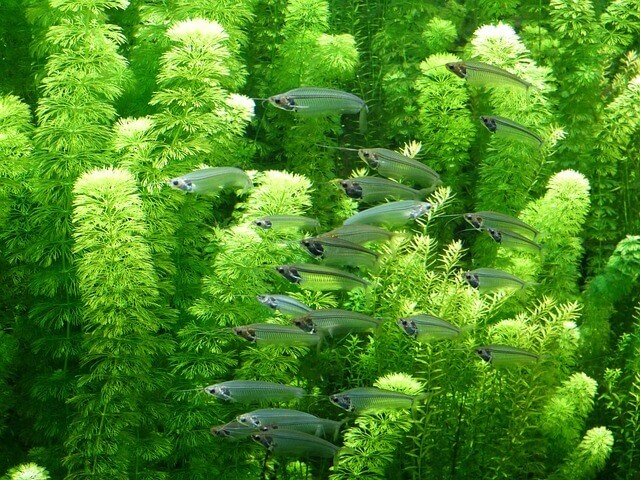Table of Contents
When it comes to maintaining a healthy and vibrant aquarium, the topic of green algae often sparks a debate among aquarium enthusiasts. Some aquarists consider green algae as a beneficial component that contributes to the overall ecosystem, while others view it as a pesky nuisance that hinders the aquarium’s aesthetics and balance.
In this blog post, we will delve into the world of green algae, exploring its benefits as well as potential problems it may pose in your aquarium. By the end, you’ll have a better understanding of whether green algae can be a friend or foe to your aquatic paradise.
Understanding Green Algae
Green algae, scientifically known as Chlorophyta, is a group of photosynthetic organisms that can thrive in various aquatic environments, including freshwater and saltwater aquariums.
They are among the oldest and most diverse forms of algae, ranging from single-celled species to more complex multicellular forms.
Green algae owe their name to the presence of chlorophyll, the green pigment responsible for photosynthesis, which enables them to convert light into energy.
In your aquarium, green algae can manifest in different forms, such as filamentous algae, hair algae, or spot algae.
While some aquarium owners may find the appearance of green algae unattractive, it is essential to recognize its ecological significance in the aquarium ecosystem.
Benefits of Green Algae in Aquariums
Balancing Nutrients
One of the primary benefits of green algae in your aquarium is its role in balancing nutrients. Like all plants, green algae require essential nutrients, such as nitrogen and phosphorus, to grow and thrive.
When present in appropriate amounts, green algae can efficiently absorb these nutrients from the water, acting as natural purifiers.
Excess nutrients in the water can result from overfeeding fish, decaying organic matter, or inadequate filtration. These surplus nutrients can lead to water quality issues, such as increased ammonia and nitrate levels, which are harmful to your aquatic inhabitants.
However, when green algae flourish, they help prevent nutrient buildup by consuming excess nitrogen and phosphorus, thus promoting a healthier aquatic environment.
Providing Oxygen
Another valuable contribution of green algae to your aquarium is their role in providing oxygen. During photosynthesis, green algae utilize carbon dioxide and release oxygen as a byproduct.
This oxygenation process is especially crucial in a closed aquatic system like an aquarium, where fish and other aquatic organisms rely on dissolved oxygen to survive.
During the day, when the aquarium lights are on, green algae actively photosynthesize, increasing oxygen levels in the water. This benefits your fish, plants, and beneficial bacteria that aid in maintaining a stable and thriving aquarium.
Moreover, the presence of green algae can help reduce the likelihood of low oxygen levels, which can occur in poorly-maintained aquariums with little plant life.
Serving as Food Source
Green algae can serve as a food source for various aquatic inhabitants, contributing to the overall ecosystem dynamics of your aquarium.
Many aquatic organisms, such as certain species of fish, snails, and shrimp, graze on green algae as part of their natural diet.
By allowing green algae to grow in controlled amounts, you create a supplementary food source for these herbivorous species, enhancing their well-being and overall health.
Additionally, some aquarium hobbyists intentionally introduce certain algae-eating fish or invertebrates, such as Siamese algae eaters or Amano shrimp, to help manage green algae growth.
These critters can play a vital role in keeping the algae population in check, preventing it from becoming excessive and unsightly.
Potential Problems with Green Algae
Overgrowth Issues
Green algae, like any other plant, requires nutrients and light to grow. While some level of algae growth is normal and can even be beneficial for certain aquarium inhabitants, excessive growth can lead to overgrowth issues. If left unchecked, green algae can rapidly cover your tank walls, decorations, and even obstruct your fish’s view.
Overgrowth can also deplete oxygen levels in the water, making it harder for your fish to breathe. Moreover, it can lead to poor water quality, which may trigger stress and health problems for your aquatic pets.
Impact on Aesthetic Appeal
An aquarium covered in a thick layer of green algae may not be the visually stunning centerpiece you had in mind. Excessive algae growth can give your tank a murky appearance, hindering the view of your beautiful fish and other inhabitants. This can be especially disappointing if you’ve put effort into creating a captivating aquascape.
Green algae overgrowth can also overshadow live plants in your tank, preventing them from photosynthesizing and thriving. As a result, the overall aesthetic appeal of your aquarium can suffer.
Controlling Green Algae Growth
Now that we’ve explored some potential problems with green algae, let’s discuss how to manage its growth and keep it in check.
Regular Cleaning
The first line of defense against green algae overgrowth is regular cleaning. Performing routine maintenance tasks, such as cleaning the glass or acrylic surfaces, removing debris, and vacuuming the substrate, can significantly reduce algae build-up.
When cleaning, try to avoid using chemical agents unless absolutely necessary, as they may harm your aquatic inhabitants.
Introduce algae-eating organisms to your tank, such as certain species of snails, shrimp, or algae-eating fish. These natural helpers can munch on algae and help keep its growth under control.
Light Control
Green algae thrive on light, so controlling the amount of light your aquarium receives can be an effective strategy to prevent overgrowth.
Limit the duration of light exposure by using a timer for your aquarium lights. Aim for around 8 to 10 hours of light per day to mimic natural day-night cycles.
Consider placing your aquarium in an area where it won’t receive direct sunlight, as this can lead to an increase in algae growth.
Also, opt for high-quality LED lights that emit the right spectrum of light for your plants without promoting excessive algae growth.
Nutrient Control
Algae, just like plants, require nutrients to grow. By managing the nutrient levels in your aquarium, you can limit the excessive growth of green algae.
Regularly test the water parameters and ensure that you’re not overfeeding your fish. Excess uneaten food can contribute to an increase in nutrients, providing a feast for algae.
Use a good filtration system to remove waste and excess nutrients from the water. Additionally, consider incorporating live plants into your aquarium setup. Live plants can compete with algae for nutrients, creating a balanced ecosystem and preventing algae from taking over.
Conclusion
In conclusion, the question of whether green algae is good for your aquarium depends on finding the right balance. When managed appropriately, green algae can offer several benefits, such as nutrient regulation, oxygen production, and serving as a food source for certain aquatic inhabitants.
However, without proper control, green algae can quickly become a nuisance, impacting the aquarium’s aesthetics and potentially harming other aquatic life.
By understanding the role of green algae in your aquarium’s ecosystem and implementing effective control measures, you can maintain a healthy, balanced, and visually appealing aquatic paradise.
Embrace the natural touch of green algae while keeping it in check, and you’ll create a harmonious environment where both your fish and plants can thrive. Happy aquascaping!







